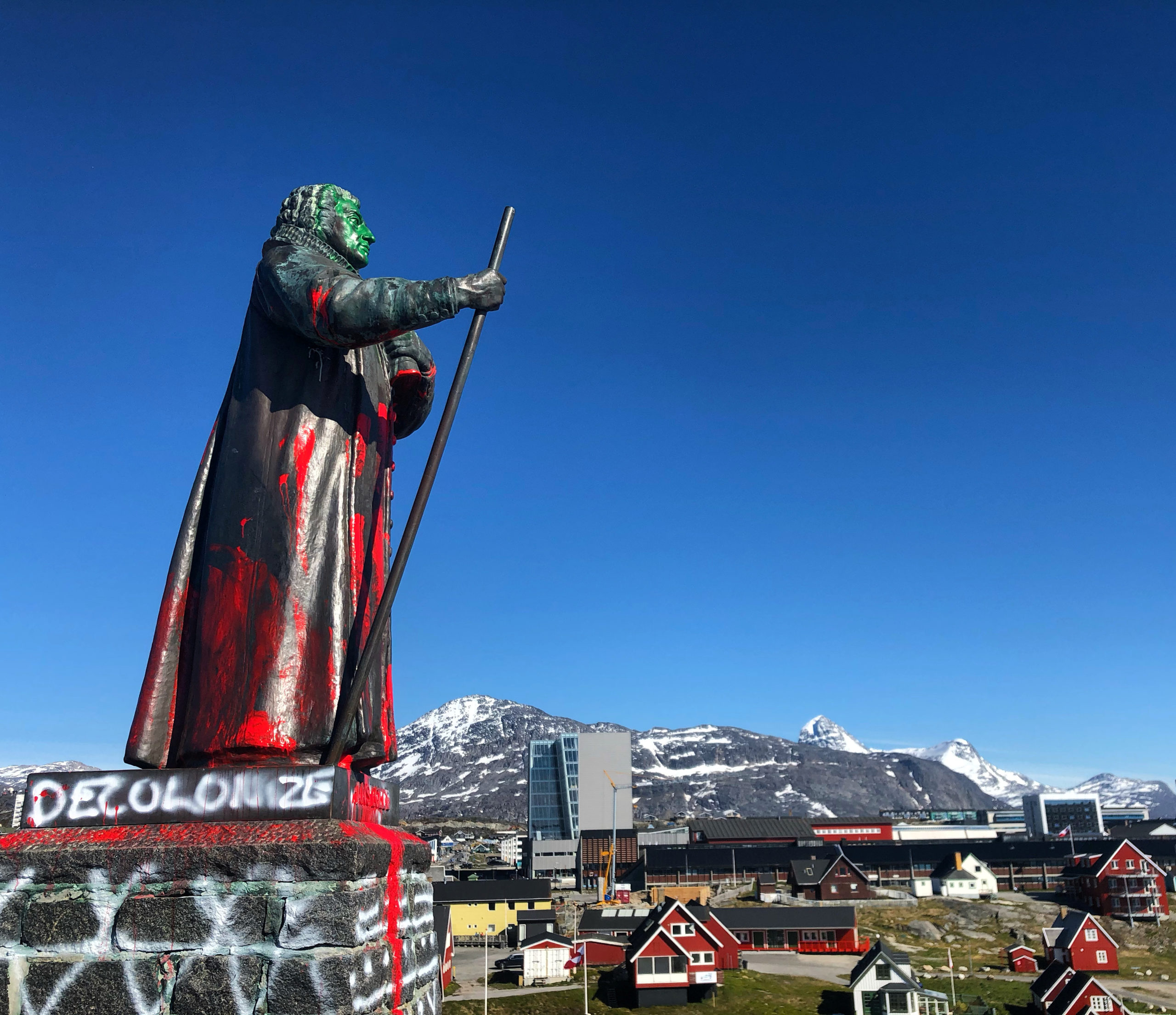In an online poll, Nuuk residents lean towards keeping Egede statue in place
Results of the poll, which continues through Tuesday, aren't binding, but they seem to show a significant majority in favor of keeping the statue of Greenland's first colonizer.

An online vote being held to determine the future of a statue in Nuuk, Greenland, that was marked with anti-colonial statements last month amidst a global backlash against racism appears to indicate that the city’s residents favor it in its prominent position above the colonial harbor.
The vote began July 3 and ends on Tuesday. As of June 17, 695 of the 23,000 people living in the Sermersooq region, which administers Nuuk, have voted to keep the statue where it is; 390 would like to see it moved.
The statue of Danish-Norwegian missionary Hans Egede was covered in red paint on the evening of June 20, the day before Greenland’s national day. The word “decolonize” and Inuit patterns were also painted on its plinth.

Four people have been charged with vandalism for the act. A statement issued at the time indicated that they were calling for the removal of the statue.
“It’s about time that we stop celebrating colonizers and that we start taking back what is rightfully ours. It’s time to decolonize our minds and our country. No colonizer deserves to be on top of a mountain like that. We need to learn the truth of our history.”
The vote about the statue’s future is not binding, and Charlotte Ludvigsen, Nuuk’s mayor, indicated from the outset that Sermersooq council would only deliberate moving it in the event of a landslide decision in favor of doing so.
“We need to see a massive number voting to move it — and, when we say massive, I’m thinking in the neighborhood of 75 percent — before we take it up in the council,” she said in connection with the decision to hold the vote.
[Greenland’s youth question colonial past in wake of Black Lives Matter]
In the event residents, who must register before they can vote, decide to remove the statue, they will be invited to propose what should be done with it, and what, if anything, should be done with the hilltop where the statue now stands.
Egede travelled to Greenland in 1721, with the backing of the Danish-Norwegian king, to find Norse settlers who had settled around 985 but who lost contact with Europe in the 15th century. No traces of the Norse were found, but Egede’s arrival marked the beginning of what became, until 1953, the country’s status as a Danish colony.
The statue in Nuuk, as well as similar statues of Egede in Copenhagen and Bergen, Norway, has become a symbol of dissatisfaction about Danish treatment of the country’s Inuit population and its continuing influence over Greenlandic affairs as it has gained increasing levels of autonomy.
As part of the poll, Nuuk residents have been invited to post their opinions about whether to move it, and how to do address Greenland’s colonial past.
[History: Why is Greenland a part of the Danish kingdom?]
The comments alternatively paint Egede as a violent colonizer or as a respected founder of Nuuk, who sought to promote the Kalaallisut language spoken by Greenland’s Inuit residents.
The council says it will hold a town hall meeting on July 20 to give residents the chance to discuss their opinions before the voting period draws to a close.
“The discussion about it (the statue, ed.) has gone off in different directions — decolonization, history, the founding of Nuuk. There are a lot of aspects to the discussion and we need to able to talk about them,” Ludvigsen told KNR, Greenland’s national broadcaster.
Some supporters of keeping the statue where it is argue that moving it would reject Egede’s contributions while doing nothing to address the problems that arose during and after Greenland was a colony.
“He is the founder of our city, and it was HE (Hans Egede, ed.) who brought Christianity to Greenland. That Hans is standing in front of the church that we consider to be our cathedral is only appropriate. What’s more, the statue was commissioned by the people of Nuuk and crafted by the people of Nuuk. Moving the statue won’t heal the scars many of us have on our souls. If he gets moved, it should be done in a way that can bring all the positive and negative aspects of his mission here in Greenland to light,” a resident named Lulu Høegh wrote.